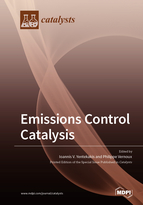Emissions Control Catalysis
A special issue of Catalysts (ISSN 2073-4344). This special issue belongs to the section "Environmental Catalysis".
Deadline for manuscript submissions: closed (31 March 2019) | Viewed by 116524
Special Issue Editors
Interests: nanomaterials and nanotechnology; heterogeneous nano-catalysis; environmental catalysis (NOx, N2O; CO, CH4, VOCs, H2S and SO2 emissions control); catalysts’ promotion; electrochemical promotion; surfaces and interfaces; electrochemistry; fuel cells; CO2 utilization; biogas and natural gas valorization
Special Issues, Collections and Topics in MDPI journals
Interests: ionically conducting ceramics as active catalyst supports; catalysis for car exhaust treatment; solid oxide fuel cells; potentiometric sensors
Special Issue Information
Dear Colleagues,
Important advances have been achieved over the past few years in agriculture, industrial technology, energy, and health, which have contributed to human well-being. However, some of these improvements in our lives have resulted in changes to the environment around us, with photochemical smog, stratospheric ozone depletion, acid rain, global warming and finally climate change being the most well-known major issues, as a result of a variety of pollutants emitted through these human activities.
Aiming to ensure that “we live well, within the planet’s ecological limits”, scientists around the world are developing tools and techniques that enable us to effectively control emissions, either of mobile (e.g., cars) or stationary (industry) sources, and to improve the quality of outdoor and indoor air, with catalysis to play a major role on these efforts. “Emissions Control Catalysis” in the frame of Environmental Catalysis is continuously growing up, providing novel multifunctional, nano-structured materials, promoted by several ways (i.e., surface or support induced promotion, electrochemical promotion, alloys, etc.) in order to be very active and selective for the abatement of a variety of pollutants and greenhouse gases, such as CO, NOx, N2O, NH3, CH4, higher hydrocarbons, Volatile Organic Compounds (VOCs) and particle matter (PM) as well as other specific pollutants emitted by industry (e.g., SOx, H2S, dioxins, aromatic hydrocarbons) or landfill and wastewater treatment plants (biogas). In many cases the concept of Cyclic Economy is concerned in emission control catalysis strategies for the production of useful chemicals and fuels from the controlled pollutants (e.g., CO2 hydrogenation, syngas production from biogas, etc.).
The present Special Issue aims to cover recent research progress in the field of the catalytic control of air pollutants emitted by mobile or stationary sources, not limited only to the abatement but also including possible cyclic economy strategies, and ranging from the synthesis, physicochemical-textural-structural characterization of the materials, activity-selectivity- durability evaluation under the considered reactions, fundamental understanding of structure-activity relationships or other metal-metal and metal-support interactions on the multifunctional materials involved, as well as simulation studies of materials, catalytic reactions and processes.
Prof. Dr. Ioannis V. Yentekakis
Dr. Philippe Vernoux
Guest Editors
Manuscript Submission Information
Manuscripts should be submitted online at www.mdpi.com by registering and logging in to this website. Once you are registered, click here to go to the submission form. Manuscripts can be submitted until the deadline. All submissions that pass pre-check are peer-reviewed. Accepted papers will be published continuously in the journal (as soon as accepted) and will be listed together on the special issue website. Research articles, review articles as well as short communications are invited. For planned papers, a title and short abstract (about 100 words) can be sent to the Editorial Office for announcement on this website.
Submitted manuscripts should not have been published previously, nor be under consideration for publication elsewhere (except conference proceedings papers). All manuscripts are thoroughly refereed through a single-blind peer-review process. A guide for authors and other relevant information for submission of manuscripts is available on the Instructions for Authors page. Catalysts is an international peer-reviewed open access monthly journal published by MDPI.
Please visit the Instructions for Authors page before submitting a manuscript. The Article Processing Charge (APC) for publication in this open access journal is 2700 CHF (Swiss Francs). Submitted papers should be well formatted and use good English. Authors may use MDPI's English editing service prior to publication or during author revisions.
Keywords
- Environmental catalysis
- NOx, N2O, NH3, CO, SOx, H2S, CH4, VOCs, aromatics, dioxins, PM pollutants abatement
- Greenhouse gases control
- Cyclic Economy
- Heterogeneous catalysis
- Structure-activity correlation
- Metal-support interactions
- Nano-structured multifunctional materials
- Automotive pollution control
- Catalyst promotion
- Electrochemical promotion







